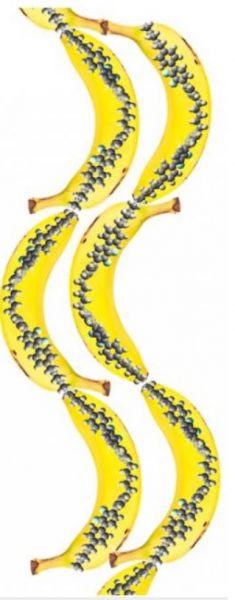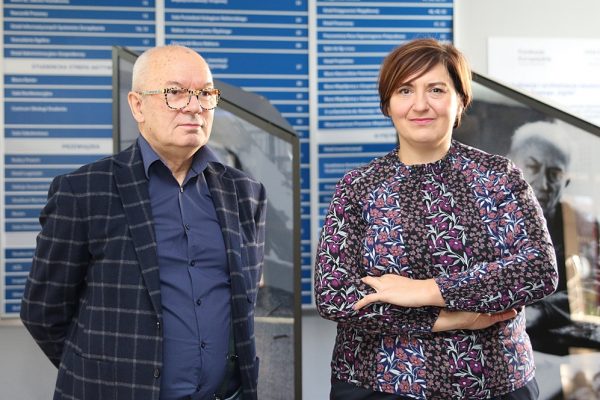It is said that information is power. Discoveries in the field of electrooptics allow us to clarify this statement. It turns out that power is held by those who get information first. Therefore, intense research is conducted all over the world to improve the data transmission process. An interesting solution has been offered by scientists from the University of Silesia in Katowice – Prof. Antoni Kocot and Dr. Katarzyna Merkel from the Faculty of Science and Technology, who specialise in nematic liquid crystal materials.
Rediscovery
There are frequently situations in science when researchers give up on a certain subject for some time, thinking that it has been exhausted and can no longer be developed. Such was the case of nematics – materials which for years have been successfully applied in liquid crystal displays that use LCD technology to display images. They are everywhere – in mobile phones, screens, digital cameras and big-screen TVs. Classic nematics have been known for over 80 years. Their electro-optic properties were described in 1960s. Since then, scientists have been searching for their practical application.
‘The constantly developing technology required research on properties and modification of the structure of these materials, which is also an object of our scientific exploration. At one point it seemed that the interest in these materials declined. However, new surprising discoveries have made us treat them with curiosity again’, says Prof. Antoni Kocot, physicist.
Each discovery brings us closer to understanding the nematic stage better. The research carried out by the scientists from the University of Silesia focuses mainly on the analysis of physical properties of these materials in relation to their structure. It is conducted, among other things, thanks to observation of the dynamics of molecular processes. Learning these properties allows to specify their potential application in a new generation of electro-optic devices.
Matches and bananas
Let us start with the meaning of the name nematics. As explained by Dr. Katarzyna Merkel, these are substances which are in the nematic phase, where molecules are arranged in a specific manner in liquid crystal.
‘The particles must adopt an elongated shape. Let us imagine molecules that resemble matches. We call them rod-shaped. When we throw them freely for example on the water, their distribution will be random. If we start to squeeze the liquid, they will automatically begin to get organised in one specific direction. The same happens with molecules, and the condition in which they are arranged in one direction we call the liquid crystal phase’, explains the researcher.
A majority of molecules in this phase are rod-shaped. However, there are also some that resemble… bananas – they are a little bent. The essential difference is that rod-shaped molecules are characterised by free rotation around their own axis. However, this feature does not apply to banana-shaped molecules. While there is no single distinguished direction during rotation, particles get spatially oriented around the shorter or longer axis. If the arrangement additionally contains bonds or functional groups with electric charge, they will also spatially correlate with the orientation of molecules. This opens up the possibility of spatial modulation of the arrangement, which can be easily controlled, for example with the use of electrical field.
Non-standard chiral structures

The shape of molecules and their spatial arrangement have key significance for the properties of the material, because they affect the creation of phases, including the twisted nematic phase, which is extremely interesting in terms of application in electrooptics.
‘Let us imagine banana-shaped molecules again. Once they start to get organised, and more precisely – when their ends come into contact with each other, they form helical screw arrangements. It’s a very interesting situation’, says Dr. Katarzyna Merkel, ‘because we deal with the so-called achiral particle. This means that the output molecule and its mirror image are identical. However, these particles form chiral structures. This happens in the case of achiral boards that someone used to make spiral, i.e. chiral stairs. It’s a breakthrough discovery!’, she adds.
Such violation of symmetry for banana-like molecules leads to the formation of a new nematic order. Helix obtained as a result of structured molecules according to their long axis may be either dextrorotary or levorotary. Such an arrangement may be further exposed to electrical field, which causes structural deformations, and thus opens up a new application space for the described arrangements. They can be successfully used, for example to build transducers in telecommunication applications.
‘Here we get to the essence of this discovery. We managed to observe and describe a new, spatially modulated nematic symmetry of the basic condition. It turns out that the banana-like shape of molecules and manner of their organisation in the nematic phase affect the dynamics of the entire arrangement. This dynamics depends on the value of helical stroke. Thanks to the arrangement structured in this way, we managed to reduce the helical stroke by several times, which causes an extremely quick electro-optic response of the arrangement. Thanks to this, information can be sent even up to one thousand times faster in comparison with the classic nematic materials, which provides the possibility of further interesting applications, for example in the military industry’, explains Prof. Antoni Kocot.
In the opinion of the scientists, the research results described in the last few scientific publications, which confirm the dynamics of the entire arrangement and the related, unusually short (submicrosecond) switching time, should also attract application interest in the field of telecommunications and technology of displays.
“Hot-papers”
Dr. Katarzyna Merkel and Prof. Antoni Kocot also described interesting changes in the structure of nematic phase as a result of the activity of surface effects and electrical field.
‘Our research results were published in „Physical Chemistry Chemical Physics” in October 2019. Let me also add that within two weeks of the date of journal publication, the article was already displayed over 200 times, which placed it on the list of the most read articles’, admits Dr. Katarzyna Merkel.
‘In our opinion, the dynamic transitions caused by electrical or magnetic field, leading to the formation of new liquid crystal phases, constitute the basis for future changes in the development of technology’, summarises the scientist.
The research project entitled “Nanostructure and dynamics of collective modes of modulated nematic phase. Electro-optic and elastic properties” was funded in a National Science Centre call.
Małgorzata Kłoskowicz
The article entitled „Nematics Conquer the World Again” was published in „Gazeta Uniwersytecka UŚ” 2019, issue no. 3 (273).






